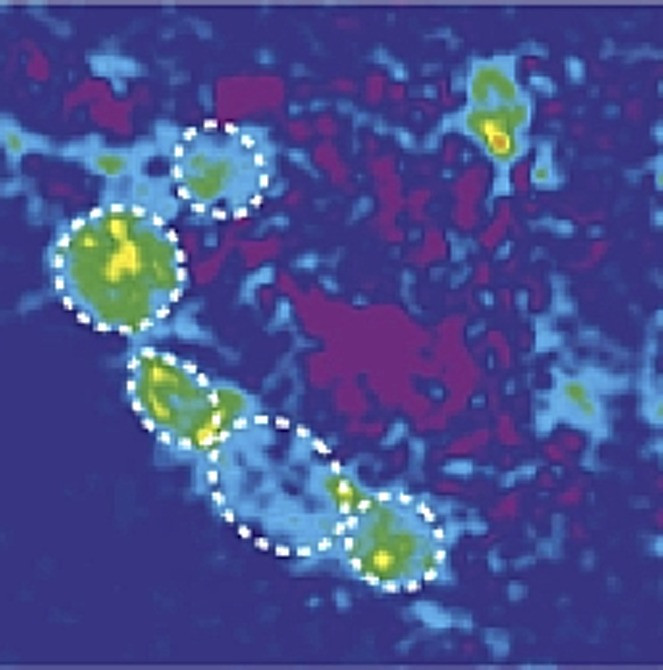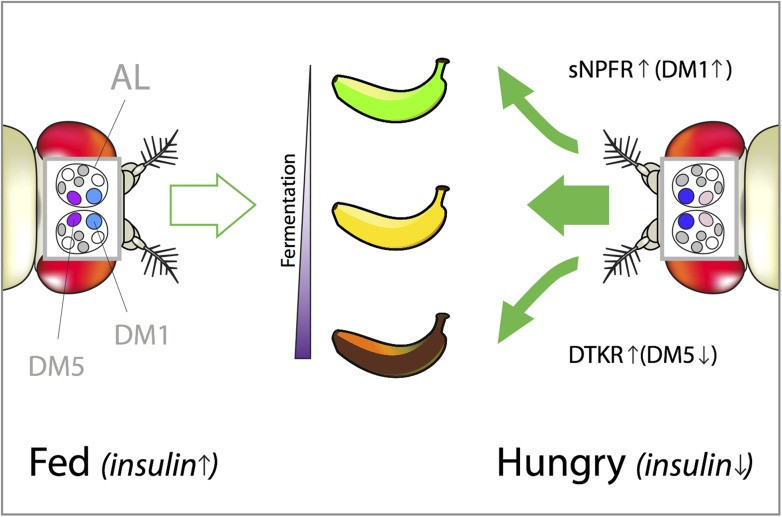It’s a common saying: “You can catch more flies with honey than with vinegar.” But when it comes to fruit flies (Drosophila melanogaster), the reality is more nuanced, especially concerning vinegar. These tiny insects, often found buzzing around overripe fruit, rely heavily on their sense of smell to locate food sources. Acetic acid, the pungent component of vinegar produced during fruit fermentation, acts as a key attractant. However, fruit flies are not blindly drawn to all concentrations of vinegar. They typically exhibit attraction to moderate levels, while ignoring or even avoiding very low (indicating unripe fruit) and very high concentrations (suggesting over-rotten fruit).
Now, groundbreaking research published in eLife by Jing Wang and colleagues at the University of California, San Diego, sheds light on the intricate brain mechanisms that modify this behavior in hungry flies. Their study, led by first author Kang Ko, reveals how starvation fundamentally alters the fruit fly’s olfactory processing, causing them to become attracted to a broader spectrum of vinegar concentrations, including those they would normally ignore. This discovery goes beyond simply increasing sensitivity to food odors; it unveils specific excitatory and inhibitory responses triggered by hunger, pushing flies to consider suboptimal food sources in their quest for sustenance. This fascinating insight might even offer a biological parallel to the human experience of hunger influencing food choices, suggesting a scientific basis for why grocery shopping on an empty stomach might lead to less discerning food selections.
The Baseline Attraction: How Fruit Flies Detect Vinegar
Understanding how hunger changes vinegar attraction requires first understanding the basic olfactory system of Drosophila. Similar to humans and other vertebrates, fruit flies utilize olfactory neurons to detect airborne chemicals. These neurons connect to glomeruli, distinct clusters within the brain acting as processing centers for specific odors. Olfactory neurons detecting the same odor converge on the same glomerulus. Vinegar, depending on its concentration, activates about 6 to 8 out of roughly 40 glomeruli in the fruit fly brain.
 Illustration depicting how hunger modifies the olfactory processing of food odors in fruit flies.
Illustration depicting how hunger modifies the olfactory processing of food odors in fruit flies.
Previous work from the Wang group pinpointed a single glomerulus, DM1, as crucial for vinegar attraction. In fact, DM1’s activity largely dictates a fly’s inclination towards vinegar. Disrupting receptors connected to DM1 eliminates vinegar attraction, while reactivating DM1 neurons in flies with a compromised sense of smell is sufficient to restore their attraction to vinegar.
Conversely, higher vinegar concentrations engage another glomerulus, DM5. DM5 activity alone explains why flies avoid excessively strong vinegar odors. The interplay between DM1 and DM5, activated at different vinegar concentrations, appears to be the deciding factor in whether a fly approaches or avoids a potential food source.
Hunger’s Influence: Expanding the Range of Attraction
Hunger dramatically impacts animal behavior, and fruit flies are no exception. Starved flies are significantly faster at locating even small amounts of vinegar-laced food compared to their well-fed counterparts. Insulin signaling plays an indirect role in this hunger-driven behavior. Starvation leads to decreased insulin levels, initiating a cascade that increases the expression of a specific receptor protein in DM1 olfactory neurons. This receptor detects short neuropeptide F, a signaling molecule. Upon binding, this neuropeptide effectively amplifies DM1 activity, increasing the fly’s sensitivity to vinegar and driving food seeking behavior. This mechanism seemed to provide a neat explanation for how insulin signaling motivates hungry flies to search more actively for food.
However, Ko and colleagues’ recent research reveals a more complex picture. By testing a broader range of vinegar concentrations, they discovered that the short neuropeptide F mechanism only explains enhanced attraction to low vinegar concentrations in hungry flies. At higher concentrations, starved flies still exhibit a stronger attraction to vinegary food than fed flies, even when short neuropeptide F signaling is reduced. This pointed towards an additional, yet unidentified, hunger signal at play.
To find this missing piece, the researchers investigated other receptor proteins that were upregulated in sensory neurons due to starvation. The Tachykinin receptor (DTKR) emerged as a promising candidate, especially because it was known to dampen olfactory neuron responses.
Unveiling the Dual Neuropeptide System
The subsequent experiments by Ko et al. elegantly demonstrated the role of DTKR. Reducing DTKR levels in hungry flies diminished their food-finding behavior specifically at high vinegar odor concentrations, but not at low concentrations. Similarly, DM5, the glomerulus responsible for vinegar avoidance at high concentrations, showed reduced activity in starved flies. However, when DTKR was suppressed, DM5 activity in starved flies returned to levels seen in fed flies. Further investigation revealed insulin as the upstream signal regulating DTKR in starved flies.
 Diagram illustrating the dual neuropeptide signaling pathways in fruit flies that modulate attraction to vinegar based on hunger state, showing the roles of sNPFR and DTKR receptors in DM1 and DM5 glomeruli.
Diagram illustrating the dual neuropeptide signaling pathways in fruit flies that modulate attraction to vinegar based on hunger state, showing the roles of sNPFR and DTKR receptors in DM1 and DM5 glomeruli.
These findings converge into a compelling model: in starved flies, decreased insulin levels trigger two complementary neuropeptide signaling systems involving short neuropeptide F and Tachykinin. One system, mediated by short neuropeptide F, enhances signal transmission in DM1, increasing sensitivity to attractive food odors at low concentrations. Simultaneously, the other system, involving Tachykinin signaling through DTKR, reduces signal transmission in DM5, decreasing avoidance of normally aversive smells, like high concentrations of vinegar. Working in concert, these two systems expand the range of vinegar concentrations attractive to hungry flies, enabling them to pursue less-than-ideal food sources when necessary.
Broader Implications for Sensory Processing
This research underscores the power of the fruit fly model for dissecting the neural computations behind sensory perception. Through sophisticated behavioral assays, genetic manipulations, and brain activity imaging, Ko and colleagues meticulously elucidated how a crucial sensory cue, like vinegar odor, is processed differently based on an animal’s internal state – hunger or satiety. The principles governing sensory processing in flies often hold true, at least in broad strokes, for other animal species, including humans. This study, therefore, contributes valuable insights into the fundamental mechanisms of sensory processing applicable across the animal kingdom.
Competing interests: The authors declare that no competing interests exist.
References
Ko KI, Root CM, Lindsay SA, Zaninovich OA, Shepherd AK, Wasserman SA, Kim SM, Wang JW. 2015. Starvation promotes concerted modulation of appetitive olfactory behavior via parallel neuromodulatory circuits. eLife 4:e08298. doi: 10.7554/eLife.08298
Semmelhack JL, Wang JW. 2009. Selectivity of olfactory neurons in Drosophila. Nature 459:218–23. doi: 10.1038/nature07984
Root CM, Masuyama H, Green KN, Enell CS, Nässel DR, Wang JW. [email protected]. Curr Biol 21:1729–34. doi: 10.1016/j.cub.2011.09.024
Ignell R, Root CM, McBride CS,ேன்ஹ்ஹ்ஹ்ஹ்ஹ்ஹ்ஹ்ஹ்ஹ்ஹ்ஹ்ஹ்ஹ்ஹ்ஹ்ஹ்ஹ்ஹ்ஹ்ஹ்ஹ்ஹ்ஹ்ஹ்ஹ்ஹ்ஹ்ஹ்ஹ்ஹ்ஹ்ஹ்ஹ்ஹ்ஹ்ஹ்ஹ்ஹ்ஹ்ஹ்ஹ்ஹ்ஹ்ஹ்ஹ்ஹ்ஹ்ஹ்ஹ்ஹ்ஹ்ஹ்ஹ்ஹ்ஹ்ஹ்ஹ்ஹ்ஹ்ஹ்ஹ்ஹ்ஹ்ஹ்ஹ்ஹ்